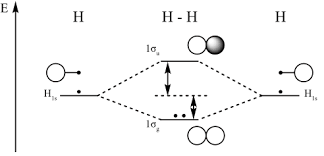How does an electron dot structure represent a covalent bond?
1 Answer
A covalent bond is conceived to be the sharing of a pair of electons by two adjacent atoms.
Explanation:
A covalent bond is conceived to be a region of high electron density between 2 adjacent, positively charged such that the nuclear-nulcear repulsion is minimized and a net attractive force results. Localized covalent bonds are thus rationalized as the sharing of 2 electrons between 2 adjacent nuclei.
For homonuclear diatomic molecules, we would depict the coupling between 2 radical atoms:
more generally:
In either case, the wavefunctions that describe the electrons on the individual atoms are conceived to overlap constructively to form a bonding orbital which populates the space between the atoms with electron density (to which the positively charged nuclei are attracted), and hence a chemical bond. This bonding orbital is at lower energy than the 2 individual atomic orbitals, and hence the bond is thermodynamically downhill. If you read further on, you will encounter the idea of destructive interference of the wave functions to form so-called anti-bonding orbitals (at higher energy than the bonding orbitals).


